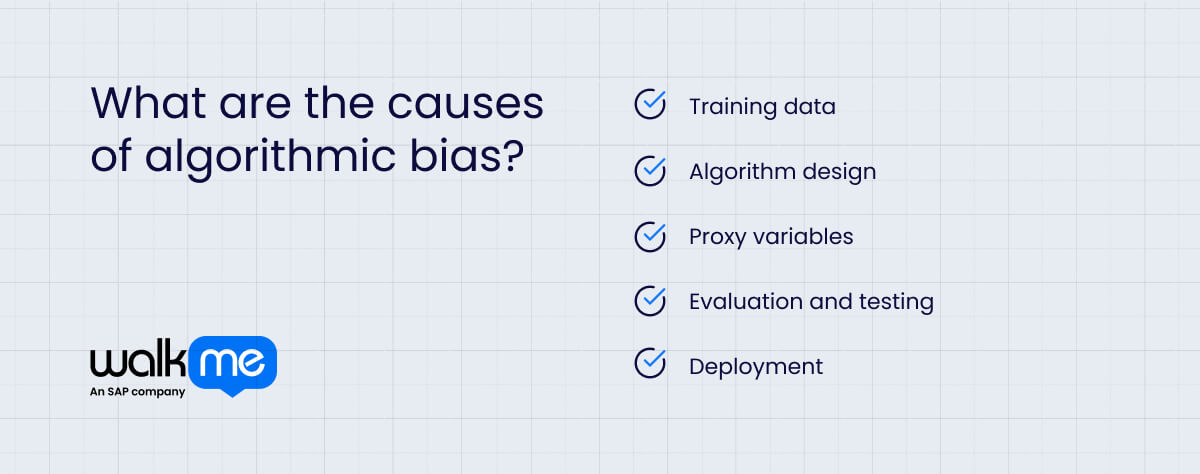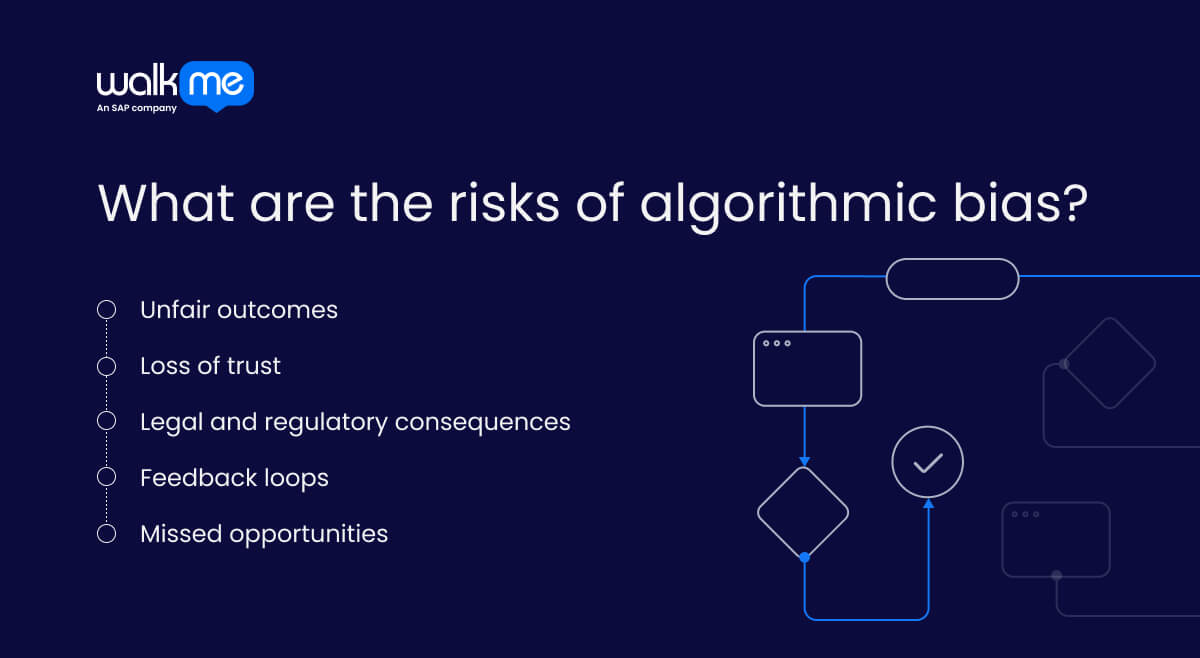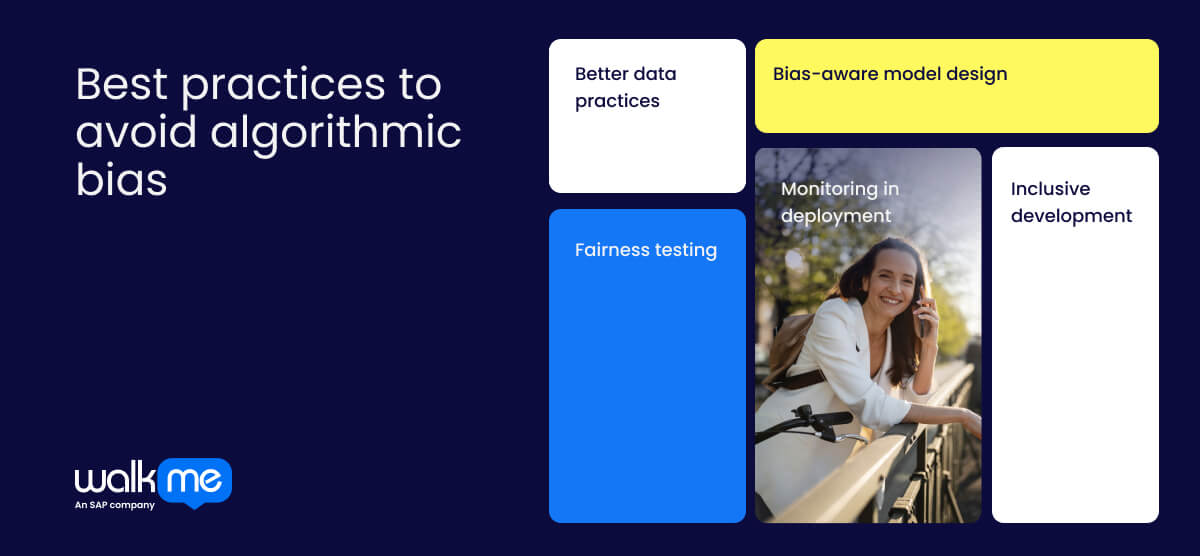What is algorithmic bias?
Algorithmic bias occurs when an algorithm produces results that are systematically unfair to specific individuals or groups. It can arise at any stage of an artificial intelligence system’s lifecycle, often due to issues with the training data, model design, or deployment context.

Table of contents
Bias may emerge when training data reflects real-world inequalities or when models rely on patterns that underrepresent or mischaracterize specific user groups. This connects to broader concerns about fairness in technology and how automated decisions can disproportionately impact certain populations.
To address algorithmic bias, developers can enhance the collection, curation, and testing of data, and continue to monitor system behavior after deployment.
Real-world examples include facial recognition systems that misidentify people from certain racial or ethnic backgrounds, as well as hiring algorithms that unfairly screen out qualified candidates based on biased input data.
What are the causes of algorithmic bias?

Algorithmic bias can enter a system at multiple stages of its lifecycle. It often results from decisions made during development, but can also emerge during deployment or through misinterpretation in real-world use.
Training data
Bias can originate in the data used to train a model. If the data reflects historical inequalities or excludes certain groups, the model may learn and perpetuate those patterns. This underscores the importance of data quality, representativeness, and integrity throughout the training process. Errors can also arise from mislabeled data or insufficient diversity in the dataset, which fails to accurately reflect real-world populations.
Algorithm design
The architecture and decision logic of a machine learning model can influence how it treats different groups. Design choices—such as how features are selected, weighted, or prioritized—can unintentionally favor one group over another. Even manual attempts to mitigate bias can introduce new trade-offs if not carefully validated.
Proxy variables
Systems may rely on indirect inputs—known as proxy variables—that correlate with sensitive characteristics such as race, gender, or socioeconomic status. For example, using location as a proxy for income may produce biased outcomes if geographic areas are strongly associated with particular communities. These correlations may be unintentional, but can still result in discriminatory effects.
Evaluation and testing
Bias can go undetected if a model is not rigorously evaluated across diverse user groups. Limited or unbalanced benchmarks may obscure the system’s performance for underrepresented populations. Comprehensive testing across demographic segments is critical for identifying performance disparities.
Deployment
Even a well-designed model can produce biased outcomes if it is applied inappropriately or misunderstood by decision-makers. Contextual factors, such as how model outputs are interpreted or operationalized, can significantly influence fairness in real-world scenarios.
What are the risks of algorithmic bias?

Algorithmic bias can lead to severe consequences when systems make decisions that significantly impact people’s lives. These risks are not just technical; they can have social, legal, reputational, and business impacts.
Here is a closer look at what can happen if algorithmic bias is not addressed:
Unfair outcomes
Biased systems can treat individuals or groups differently based on race, gender, location, or other traits. Discrimination can occur in real-world contexts, such as hiring processes and legal decisions, which can have a profound impact on individuals.
Loss of trust
When people discover that automated systems produce biased results, it can damage public confidence in AI tools and the organizations that use them, significantly impacting customer experience and brand loyalty. Users may become reluctant to engage with the system or the organization behind it.
Legal and regulatory consequences
Organizations using biased systems face increasing legal and compliance risks. Regulations such as the EU AI Act and the proposed Algorithmic Accountability Act mandate fairness, transparency, and oversight in AI systems. According to Gartner, by 2026, 50% of governments worldwide will require responsible AI practices, including active mitigation of algorithmic bias.
Feedback loops
When biased outputs are fed back into training data, the model can reinforce and amplify those biases over time. These feedback loops make it more challenging to correct course later and can entrench flawed decision-making.
Missed opportunities
Bias doesn’t only lead to harm—it can also limit a system’s effectiveness. For example, it may fail to identify high-potential candidates in recruitment or overlook meaningful risk indicators in finance. These blind spots can reduce the model’s business value and lead to underperformance.
Best practices to avoid algorithmic bias

Reducing algorithmic bias requires vigilance at every stage of an AI system’s development, testing, and deployment. The following practices help mitigate the risk of unfair outcomes and enhance the performance of AI systems in real-world settings.
Better data practices
Bias often originates in the training data. Using datasets that reflect the full range of individuals the system will impact helps reduce the risk of underrepresentation or skewed outcomes. Data should be audited for balance, completeness, and accuracy before model development begins.
Bias-aware model design
Design choices can shape how a model treats different groups. Some models may give disproportionate weight to certain features, leading to uneven outcomes. Conducting early sensitivity analyses and feature audits can help identify hidden assumptions that may influence fairness.
Fairness testing
Pre-deployment testing for bias is critical to ensuring equitable outcomes across different user groups. Running evaluations with fairness metrics, such as disparate impact ratios or equal opportunity measures, and comparing outputs across demographics can highlight patterns that require correction. This supports more ethical and accountable decision-making.
Monitoring in deployment
Even well-tested systems can behave differently once they’re live. Regular monitoring helps catch problems early and makes it easier to update systems if bias appears over time, requiring a robust governance process to oversee AI system performance.
Inclusive development
Building systems with input from people with diverse backgrounds and perspectives helps surface bias early. Cross-functional and inclusive teams are more likely to challenge default assumptions and anticipate equity concerns that homogeneous teams might miss.